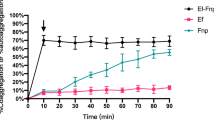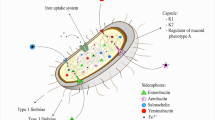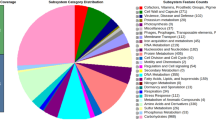Abstract
Campylobacter jejuni undergoes a dramatic morphological transformation from a corkscrew-shaped rod to a coccoid form in response to unfavorable conditions. It has been speculated that the coccoid plays an important role in the survival and dissemination of C. jejuni but questions still remain regarding the viability of coccoid cells. Characterization of the genome of coccoid cells found that newly formed coccoid cells (i.e., 1–3 days) had a SmaI-digestion profile identical to that of spiral-shaped cells; however, there was a progressive degradation of the DNA with continued incubation at 37°C. Concomitant with genome degradation was the detection of DNA in supernatants of coccoid cells. In contrast, cells incubated at 4°C retained a spiral shape and their SmaI-digestion profile for 8 weeks and released little DNA into the medium. Thus, low temperature inhibited both coccoid formation and genome degradation. Collectively, these data support the theory that the coccoid form of C. jejuni is a manifestation of cellular degradation and spiral-shaped cells, or possibly coccoid cells formed at low temperature, are the most probable candidates for a viable but nonculturable form of this pathogen.


Similar content being viewed by others
Literature Cited
RR Beumer J Vries Particlede FM Rombouts (1992) ArticleTitleCampylobacter jejuni non-culturable coccoid cells Int J Food Microbiol 15 153–163 Occurrence Handle10.1016/0168-1605(92)90144-R
SN Boucher BR Slater AHL Chamberlain MR Adams (1994) ArticleTitleProduction and viability of coccoid forms of Campylobacter jejuni J Appl Bacteriol 77 303–307
C Buchrieser O Buchrieser A Kristl CW Kaspar (1994) ArticleTitleClamped homogenous electric fields (CHEF) gel electrophoresis of DNA restriction fragments for comparing genomic variations among strains of Yersinia enterocolitica and Yersinia spp Zbl Bakt 281 451–470
JM Cappelier C Magras JL Louve M Federighi (1999) ArticleTitleRecovery of viable but non-culturable Campylobacter jejuni cells in two animal models Food Microbiol 16 375–383 Occurrence Handle10.1006/fmic.1998.0246
KF Chan HL Tran RY Kanenaka S Kathariou (2001) ArticleTitleSurvival of clinical and poultry-derived isolates of Campylobacter jejuni at a low temperature (4°C) Appl Environ Microbiol 67 4186–4191 Occurrence Handle10.1128/AEM.67.9.4186-4191.2001
WC Hazeleger JD Janse PMFJ Koenraad RR Beumer FM Rombouts T Abee (1995) ArticleTitleTemperature-dependent membrane fatty acid and cell physiology changes in coccoid forms of Campylobacter jejuni Appl Environ Microbiol 61 2713–2719
WC Hazeleger JA Wouters FM Rombouts FM Abee (1998) ArticleTitlePhysiological activity of Campylobacter jejuni far below the minimal growth temperature Appl Environ Microbiol 64 3917–3922
JE Hobbie RJ Daley S Jasper (1977) ArticleTitleUse of Nucleopore filters for counting bacteria by fluorescence microscopy Appl Environ Microbiol 33 1225–1228 Occurrence Handle1:STN:280:CSiB38%2FjvVE%3D Occurrence Handle327932
C Höller D Witthuhn B Janzen-Blunck (1998) ArticleTitleEffect of low temperatures on growth, structure, and metabolism of Campylobacter coli SP10 Appl Environ Microbiol 64 581–587
DM Jones EM Sutcliffe A Curry (1991) ArticleTitleRecovery of viable but non-culturable Campylobacter jejuni J Gen Microbiol 137 2477–2482
DB Kell AS Kaprelyants DH Weichart CR Harwood MR Barer (1998) ArticleTitleViability and activity in readily culturable bacteria: a review and discussion of the practical issues Ant van Leeuwenhoek 73 169–187 Occurrence Handle10.1023/A:1000664013047
B Lázaro J Cárcamo A Audícana I Perales A Fernández-Astorga (1999) ArticleTitleViability and DNA maintenance in nonculturable spiral Campylobacter jejuni cells after long-term exposure to low temperature Appl Environ Microbiol 65 4677–4681
GJ Medema PM Schets AW Giessen Particlevan de AH Havelaar (1992) ArticleTitleLack of colonization of 1 day old chicks by viable, non-culturable Campylobacter jejuni J Appl Bacteriol 72 512–516
JE Moore (2001) ArticleTitleBacterial dormancy in Campylobacter: Abstract theory or cause for concern? Int J Food Sci 36 593–600 Occurrence Handle10.1046/j.1365-2621.2001.00508.x
AP Moran ME Upton (1986) ArticleTitleA comparative study of the rod and coccoid forms of Campylobacter jejuni ATCC 29428 J Appl Bacteriol 60 103–110
AP Moran MB Upton (1987) ArticleTitleEffect of medium supplements, illumination and superoxide dismutase on the production of coccoid forms of Campylobacter jejuni ATCC 29428 J Appl Bacteriol 62 43–51
AP Moran ME Upton (1987) ArticleTitleFactors affecting production of coccoid forms by Campylobacter jejuni on solid media during incubation J Appl Bacteriol 62 527–537
I Nachamkin (1997) Campylobacter jejuni MP Doyle LR Beuchat TJ Montville (Eds) Food microbiology: fundamentals and frontiers ASM press Washington, DC 159–170
JH Paul B Myers (1982) ArticleTitleFluorometric determination of DNA in aquatic microorganisms by use of Hoechst 33258 Appl Environ Microbiol 43 1393–1399
DM Rollins RR Colwell (1986) ArticleTitleViable but nonculturable stage of Campylobacter jejuni and its role in survival in the natural aquatic environment Appl Environ Microbiol 52 531–538
NJ Stern DM Jones IV Wesley DM Rollins (1995) ArticleTitleColonization of chicks by non-culturable Campylobacter spp Lett Appl Microbiol 18 333–336
R Talibart M Denis A Castillo JM Cappelier G Ermel (2000) ArticleTitleSurvival and recovery of viable but nonculturable forms of Campylobacter in aqueous microcosm Int J Food Microbiol 55 263–267 Occurrence Handle10.1016/S0168-1605(00)00201-4
RV Tauxe (1991) Epidemiology of Campylobacter jejuni infections in the United States and other industrialized nations I Nachamkin MJ Blaser LS Tompkins (Eds) Campylobacter jejuni: current status and future trends ASM Press Washington, DC 9–19
JM Tholozan JM Cappelier JP Tissier G Delattre M Federighi (1999) ArticleTitlePhysiological characterization of viable-but-nonculturable Campylobacter jejuni cells Appl Environ Microbiol 65 1110–1116
Acknowledgments
The technical assistance of Barbara Cochrane is greatly appreciated. This work was supported by Hatch Grant WIS03640, from the Wisconsin Agricultural Experiment Station, and the College of Agricultural and Life Sciences, University of Wisconsin—Madison.
Author information
Authors and Affiliations
Corresponding author
Rights and permissions
About this article
Cite this article
Hudock, J.F., Borger, A.C. & Kaspar, C.W. Temperature-Dependent Genome Degradation in the Coccoid Form of Campylobacter jejuni. Curr Microbiol 50, 110–113 (2005). https://doi.org/10.1007/s00284-004-4400-x
Received:
Accepted:
Published:
Issue Date:
DOI: https://doi.org/10.1007/s00284-004-4400-x




